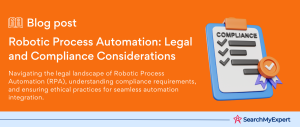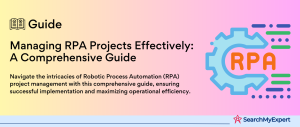Understanding the Role of Robotic Process Automation (RPA) in Transforming Today’s Workforce
In the ever-evolving landscape of business technology, Robotic Process Automation (RPA) stands out as a revolutionary force, significantly altering how companies operate and compete. At its core, RPA refers to the use of software robots or “bots” that mimic human actions to complete repetitive and time-consuming tasks. This innovative technology is swiftly becoming a cornerstone in the digital transformation strategies of businesses across various industries.
RPA: A Catalyst for Change in Business Operations
The implementation of RPA has ushered in a new era of efficiency and productivity. By automating routine tasks such as data entry, invoice processing, and customer service inquiries, RPA frees up human employees to focus on more complex, creative, and value-added activities. This shift not only enhances operational efficiency but also drives significant cost savings, leading to a more agile and competitive business environment.
RPA and Workforce Transformation: Navigating the New Landscape
As RPA continues to gain traction, its impact on the workforce is undeniable. The rise of automation has sparked a paradigm shift in job roles and responsibilities, necessitating a reevaluation of skills and competencies. This transition is not about replacing human labor but rather about complementing and augmenting it with robotic efficiency. Employees are now required to adapt to this changing landscape, embracing new skills and roles that go hand-in-hand with automated processes.
Embracing the Future: The Need for Adaptation and Skill Development
The integration of RPA into business processes is not just a technological upgrade but a strategic move towards a more innovative and resilient workforce. Companies must invest in training and development programs to equip their employees with the necessary skills to thrive in this automated environment. This includes fostering digital literacy, problem-solving capabilities, and an understanding of how to work alongside digital workers effectively.
Maximizing Workforce Potential: The Benefits of RPA in Business Efficiency
Robotic Process Automation (RPA) is not just a technological advancement; it’s a strategic tool for reshaping the modern workforce. By automating mundane and repetitive tasks, RPA is revolutionizing how businesses operate and how employees engage with their work. Let’s dive into the key benefits RPA brings to workforce transformation.
Automation of Repetitive Tasks: A Gateway to Higher-Value Work
At the heart of RPA’s impact is its ability to take over repetitive, manual tasks that have traditionally consumed a significant portion of employees’ time. Tasks like data entry, form processing, and routine communications can now be handled by software bots. This shift allows human workers to redirect their focus towards more strategic, creative, and interpersonal activities that add greater value to the business. As a result, employees can engage in roles that are more fulfilling and intellectually stimulating, leading to a more dynamic and innovative workplace culture.
Enhanced Productivity and Efficiency: Doing More with Less
RPA offers an unmatched level of efficiency. Bots can operate 24/7 without breaks, enabling a continuous workflow that is not possible with a human-only workforce. This round-the-clock operation leads to a significant uptick in productivity, as tasks that previously took hours can now be completed in a fraction of the time. Additionally, RPA can handle multiple tasks simultaneously, scaling its efforts according to the business’s needs without the requirement for additional resources.
Unparalleled Accuracy and Consistency: Minimizing Errors
Human error is an inevitable aspect of manual processes, but RPA offers a solution. Software bots are programmed to follow specific rules and processes, ensuring tasks are performed with high accuracy and consistency. This precision is particularly crucial in industries where errors can have significant consequences, such as finance and healthcare. By reducing mistakes, RPA not only improves the quality of work but also mitigates risks and compliance issues.
Cost Savings: A Financially Savvy Investment
Implementing RPA can lead to substantial cost savings for businesses. By automating routine tasks, companies can reduce their reliance on manual labor for these functions, leading to savings on labor costs. Additionally, the efficiency and speed of RPA can result in reduced operational costs, as tasks are completed faster and with fewer errors.
Boosted Employee Morale and Job Satisfaction
The introduction of RPA can have a positive impact on employee morale. By taking over mundane tasks, RPA allows employees to focus on more engaging and meaningful work. This shift can lead to increased job satisfaction, as employees feel their skills are being used more effectively. Furthermore, a reduced workload can lead to better work-life balance, decreasing burnout and improving overall employee well-being.
Navigating the Challenges of RPA Implementation in Workforce Management
While Robotic Process Automation (RPA) offers significant benefits, its implementation is not without challenges. Understanding and addressing these challenges is crucial for businesses to fully leverage the advantages of RPA while minimizing its potential drawbacks.
Addressing Job Displacement and Workforce Anxiety
One of the primary concerns surrounding RPA is the fear of job displacement. As automation takes over certain tasks, there is a prevailing apprehension among employees about the security of their roles. This anxiety can be mitigated by clear communication from leadership regarding the purpose and benefits of RPA. It’s essential to emphasize that RPA is not a replacement for human workers but a tool to augment their capabilities and eliminate the need for tedious tasks.
The Imperative of Reskilling and Upskilling
The introduction of RPA creates a demand for new skill sets in the workforce. To ensure employees remain valuable and relevant, businesses must invest in reskilling and upskilling initiatives. These programs should focus on developing digital literacy, problem-solving skills, and the ability to work alongside automated systems. By equipping employees with these new skills, companies can help their workforce transition into more strategic and fulfilling roles, ensuring their long-term employability.
Managing the Transition: A Strategic Approach
Implementing RPA requires a well-thought-out strategy that takes into account the impact on employees and the business as a whole. Key considerations include:
- Creating a Phased Implementation Plan: Gradually introducing RPA allows employees to adjust to the new technology and reduces the risk of operational disruptions.
- Involving Employees in the Process: Engaging employees in the implementation process can help in identifying the best areas for automation and foster a sense of ownership and acceptance.
- Providing Training and Support: Offering comprehensive training and ongoing support helps employees adapt to new systems and reduces resistance to change.
Fostering Employee Buy-In: The Role of Leadership
Leadership plays a crucial role in fostering employee buy-in for RPA initiatives. Transparent communication about the benefits and goals of RPA, along with a clear vision of the company’s future, can alleviate fears and build trust. Additionally, highlighting success stories and celebrating milestones can reinforce the positive aspects of RPA implementation.
The Essential Skills for Thriving in an RPA-Transformed Workforce
As Robotic Process Automation (RPA) continues to reshape the business landscape, the skill set required for success in the workforce is evolving. In an RPA-driven environment, certain competencies and skills become increasingly critical. Let’s explore these key areas that professionals need to focus on to excel in this new era.
Digital Literacy: Navigating the Technological Landscape
In an RPA-centric workplace, digital literacy is fundamental. This encompasses a basic understanding of how RPA tools work and the ability to interact with these technologies effectively. Professionals should be comfortable using a range of digital tools and platforms and have a foundational knowledge of how automation impacts their specific job roles.
Data Analysis: The Power of Information
RPA often involves handling vast amounts of data. Therefore, the ability to analyze and interpret this data is crucial. Skills in data analysis enable employees to make informed decisions based on the insights derived from automated processes. Understanding data trends, anomalies, and patterns is essential for optimizing RPA strategies and driving business outcomes.
Critical Thinking and Problem-Solving: Navigating Complex Challenges
Critical thinking and problem-solving skills are invaluable in an RPA-transformed environment. As automation handles routine tasks, employees are increasingly confronted with complex challenges that require thoughtful analysis and creative solutions. The ability to think critically helps in optimizing RPA processes and addressing any issues that may arise.
Collaboration and Communication: Key to Team Success
Even in an automated workplace, collaboration and communication remain vital. Professionals need to work effectively with both human colleagues and digital workers (bots). This includes communicating complex technical concepts in simple terms, working in cross-functional teams, and building strong interpersonal relationships. Effective collaboration and communication ensure that RPA initiatives are aligned with overall business goals and that all team members are on the same page.
Adaptability and Continuous Learning: Keeping Pace with Change
The fast-paced nature of technological advancement, especially in the field of RPA, requires a mindset of adaptability and continuous learning. Professionals should be open to updating their skills and knowledge regularly to stay relevant and effective in their roles. This may involve pursuing additional training, attending workshops, or keeping abreast of the latest trends and best practices in RPA.
Strategic Approaches to Facilitating Effective Workforce Transformation with RPA
As businesses increasingly adopt Robotic Process Automation (RPA), it’s critical to have strategic approaches in place to prepare the workforce for this transition. Effective workforce transformation not only involves introducing new technologies but also ensuring that employees are equipped and ready to thrive in an RPA-enhanced work environment. Here are key strategies to facilitate this process:
Comprehensive Communication: The Foundation of Change
Clear and consistent communication is paramount in managing the transition to an RPA-driven workplace. This involves:
- Explaining the Purpose and Benefits of RPA:
Employees should understand how RPA will benefit the organization and their individual roles. - Addressing Concerns and Providing Reassurance:
Open forums and Q&A sessions can be effective in addressing employee concerns about job security and changes in their roles. - Keeping the Workforce Informed:
Regular updates about the RPA implementation process help in maintaining transparency and building trust.
Robust Training Programs: Equipping Employees with New Skills
Investing in comprehensive training programs is essential for upskilling employees to work effectively with RPA tools. These programs should:
- Cover Basic Digital Literacy and RPA Tools Usage:
Ensuring that all employees have a foundational understanding of digital technologies and how to interact with RPA systems. - Focus on Advanced Skills for Specific Roles:
For roles deeply integrated with RPA, more advanced and specialized training may be necessary. - Be Continuous and Evolving:
As RPA technologies advance, training programs should also evolve to keep pace with new developments.
Career Development Opportunities: Fostering Growth and Adaptability
Creating pathways for career development is crucial for employee motivation and retention during times of change. This includes:
- Identifying New Roles and Career Paths:
As RPA transforms job roles, identify new opportunities within the organization where employees can apply their skills. - Encouraging Internal Mobility: Facilitate the transition of employees into new roles that emerge as a result of RPA adoption.
- Providing Support for Skill Advancement: Offer resources and support for employees interested in learning new skills or advancing their careers in the new landscape.
Implementing Robust Change Management Processes
Change management is key to a smooth transition to an RPA-enhanced workplace. Effective change management should:
- Involve Leadership at All Levels:
Strong leadership support helps in driving the change and setting a positive tone throughout the organization. - Be Structured Yet Flexible:
While having a structured approach is necessary, flexibility to adapt to unforeseen challenges is also important. - Include Feedback Mechanisms: Regular feedback from employees can help in adjusting strategies and addressing issues promptly.
Real-World Success Stories of RPA Implementation and Workforce Transformation
The implementation of Robotic Process Automation (RPA) across various industries has led to significant transformations in workforce dynamics and business operations. Let’s explore some inspiring real-world examples that showcase the successful integration of RPA and its positive impact on employees and business outcomes.
Healthcare Industry: Enhancing Efficiency and Patient Care
In healthcare, RPA has revolutionized several areas:
- Payment Processing: Automating payment processes in hospitals has reduced staff workload and positively impacted Revenue Cycle Management.
- Claims Management:
RPA bots automate insurance claims management, streamlining the process for patients and hospitals. - Patient Registration:
The automation of patient registration forms speeds up this time-consuming task, improving efficiency and patient experience.
Manufacturing Industry: Boosting Productivity and Decision Making
Examples in the manufacturing sector include:
- Eastman Chemical:
This global specialty materials company employed RPA in finance and later expanded its use to supply chain and procurement, leading to over 20,000 hours saved annually. - Schneider Electric Europe:
The company used RPA to eliminate repetitive document preparation and streamline new supply chain processes for PPE during the COVID-19 crisis, achieving a 99% reduction in processing time. - Amber Beverage Group:
Automated key processes involving approvals of purchase orders, significantly enhancing employee efficiency and customer service.
Telecom Industry: Streamlining Operations
In telecommunications, RPA has been effectively used for:
- Account Verification:
Automating the verification process for postpaid accounts. - Reporting:
Generating automated reports on connectivity issues. - Easy Request Forwarding: Using bots to automatically forward customer emails based on parameters.
Banking and Financial Sector: Improving Accuracy and Response Times
The banking sector has seen transformative benefits:
- Credit Checks and Data Entry:
Automating credit checks and customer data entry has streamlined loan processing and account management. - KYC Processes:
Partial automation of KYC processes improves efficiency while maintaining compliance.
IT Industry: Enhancing Productivity in Software Development
In the technology sector, RPA has been used for:
- Automating Tool Installation: Streamlining the setup of development environments.
- Automation Testing:
Enhancing the efficiency and accuracy of software testing processes.
These case studies demonstrate how RPA can not only improve business processes but also positively impact the workforce by freeing employees from repetitive tasks, allowing them to focus on more strategic and creative aspects of their jobs. The key takeaway is that RPA when implemented effectively, can lead to increased efficiency, better employee satisfaction, and significant business growth.
Embracing the Future: The Transformative Impact of RPA on the Workforce
As we reflect on the journey through the realms of Robotic Process Automation (RPA) and its influence on workforce transformation, it’s clear that this innovative technology is more than just a fleeting trend; it’s a pivotal element in shaping the future of work.
Key Takeaways from Our Exploration of RPA
- Introduction to RPA:
We began by introducing RPA, a technology that automates routine tasks, thus marking a significant shift in how businesses operate and employees engage with their work. - Benefits of RPA:
The advantages of RPA in workforce transformation are evident, from increasing productivity and accuracy to enhancing employee morale through the elimination of monotonous tasks. - Challenges and Solutions:
Acknowledging the challenges of RPA, particularly in workforce adaptation, we emphasized the importance of reskilling, upskilling, and effective change management. - Skills for the Future:
We identified key skills necessary in an RPA-enhanced workplace, including digital literacy, data analysis, and critical thinking, alongside the ever-important soft skills like collaboration and communication. - Strategies for Workforce Transformation:
Effective strategies, such as comprehensive training programs and robust communication plans, are essential for a smooth transition to RPA. - Real-World Success Stories: Through various case studies across industries, we illustrated how RPA is already revolutionizing businesses and positively impacting employees.
RPA: A Stepping Stone to a Brighter Future of Work
The potential of RPA for transforming the workplace is immense. When handled effectively, it paves the way for more efficient, innovative, and fulfilling work environments. RPA is not just about automating tasks; it’s about augmenting human capabilities and creating new opportunities for growth and development.
Looking Ahead: The Evolving Role of RPA
As we look to the future, the role of RPA in the workplace will continue to evolve, driven by advancements in AI and machine learning. The integration of RPA with these technologies promises even more sophisticated automation solutions, capable of performing complex tasks and providing deeper insights.
Conclusion:
The rise of Robotic Process Automation (RPA) isn’t about replacing humans, but about redefining work for the better. By embracing RPA, companies can not only achieve greater efficiency and accuracy, but also free up their human workforce to focus on creativity, innovation, and tasks that truly require a human touch. This requires proactive skills development, open communication, and a commitment to employee growth. The companies that prioritize these aspects will not only weather the changing tides of automation, but thrive in a transformed future where humans and machines collaborate to create new possibilities.
Leverage the expertise of Robotic Process Automation Service Agencies for superior automation.
Further Reading
Table of Contents
Toggle






